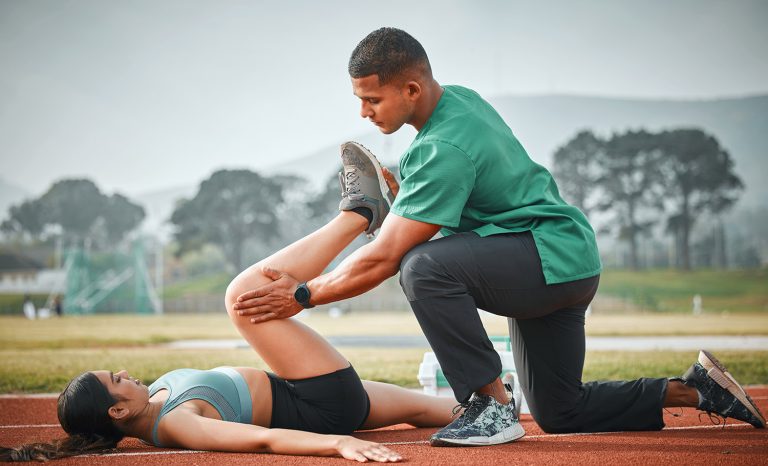

Injury Prevention in Sports
Essential Tips from Professional Therapists
Engaging in sports provides numerous benefits, including improved physical fitness, mental health, and social connections. However, the physical demands of athletic activities can also lead to injuries. Understanding common sports injuries and implementing injury prevention measures can help athletes stay injury-free and perform at their best. At Kinetic Physical Therapy and Wellness in Greenville, NC, our professional sports therapy team emphasizes the importance of injury prevention. In this blog post, we will discuss common sports injuries and offer expert advice on how athletes can protect themselves.
Common Sports Injuries
- Sprains and Strains
Sprains involve the overstretching or tearing of ligaments, the tough bands of tissue that connect bones to one another at a joint. Strains are similar but affect muscles or tendons. These injuries typically occur when an athlete falls, twists, or experiences a sudden impact.
- Knee Injuries
Knee injuries are common in sports that involve running, jumping, and sudden changes in direction. Conditions such as anterior cruciate ligament (ACL) tears, meniscus injuries, and patellar tendinitis can sideline athletes for extended periods.
- Shin Splints
Shin splints refer to pain along the shin bone (tibia) and are common in runners. They result from repetitive stress on the shinbone and the connective tissues that attach muscles to the bone.
- Fractures
Fractures or broken bones can occur from direct trauma, falls, or excessive force. Stress fractures, a type of fracture resulting from repetitive force or overuse, are common in athletes.
- Dislocations
Dislocations happen when the ends of your bones are forced out of their normal positions. This painful injury temporarily deforms and immobilizes your joint.
- Tendon Injuries
Tendonitis and tendinosis are common overuse injuries that affect the tendons, the thick cords that attach muscles to bones. These injuries can occur in various parts of the body, including the shoulders, elbows, and Achilles tendon.
Injury Prevention Measures
Preventing sports injuries involves a combination of proper training, technique, and self-care. Here are some essential tips from our professional therapists:
- Warm-Up and Cool Down Properly
Always begin your training session or game with a proper warm-up. Warming up increases blood flow to the muscles, enhancing flexibility and reducing the risk of injury. A good warm-up should include light aerobic exercises, such as jogging or jumping jacks, followed by dynamic stretches. Cooling down after exercise is equally important. It helps your heart rate and breathing return to normal and aids in muscle recovery. Include static stretching and light aerobic activities in your cool-down routine.
- Use Proper Equipment
Using the right equipment can significantly reduce the risk of injuries. Ensure that you wear appropriate footwear that provides adequate support and fits well. Protective gear, such as helmets, pads, and braces, should also be used when necessary and should be in good condition.
- Focus on Technique
Proper technique is crucial in preventing injuries. Whether you’re lifting weights, running, or playing a specific sport, make sure you’re using the correct form. Consider working with a coach or a physical therapist to learn and maintain proper techniques.
- Gradually Increase Intensity
Avoid the temptation to push yourself too hard too quickly. Gradually increase the intensity, duration, and frequency of your workouts. This progressive approach allows your body to adapt to the increased demands and reduces the risk of overuse injuries.
- Strengthen Muscles and Improve Flexibility
Strength training and flexibility exercises are key components of injury prevention. Strong muscles support and protect your joints, while flexibility helps maintain a full range of motion. Incorporate strength training exercises that target all major muscle groups and include regular stretching sessions in your routine.
- Stay Hydrated and Maintain a Balanced Diet
Proper nutrition and hydration play a vital role in maintaining overall health and preventing injuries. Dehydration can lead to muscle cramps and fatigue, increasing the risk of injury. Ensure you’re drinking enough water throughout the day and during exercise. Additionally, consume a balanced diet rich in essential nutrients to support muscle function and repair.
- Listen to Your Body
Pay attention to your body and recognize the signs of overtraining or potential injury. Pain, soreness, and fatigue are signals that your body needs rest. Ignoring these signs can lead to more severe injuries. Incorporate rest days into your training schedule and seek medical advice if you experience persistent pain or discomfort.
- Cross-Train
Engaging in a variety of physical activities can help prevent overuse injuries by distributing the stress placed on specific muscles and joints. Cross-training allows you to work different muscle groups and can improve your overall fitness and performance.
- Regular Check-Ups with a Physical Therapist
Regular visits to a physical therapist can help identify potential issues before they become serious problems. A physical therapist can assess your movement patterns, strength, and flexibility, providing personalized recommendations to prevent injuries.
Injury prevention is an essential aspect of sports performance. By understanding common sports injuries and implementing preventive measures, athletes can reduce their risk of injury and maintain their competitive edge. At Kinetic Physical Therapy and Wellness in Greenville, NC, our professional therapists are dedicated to helping athletes stay healthy and perform at their best. If you have any concerns about sports injuries or need personalized advice, don’t hesitate to reach out to us. Remember, taking proactive steps today can keep you in the game tomorrow.
Please Share
categories
Recent Posts

Injury Prevention in Sports
Essential Tips from Professional Therapists
Engaging in sports provides numerous benefits, including improved physical fitness, mental health, and social connections. However, the physical demands of athletic activities can also lead to injuries. Understanding common sports injuries and implementing injury prevention measures can help athletes stay injury-free and perform at their best. At Kinetic Physical Therapy and Wellness in Greenville, NC, our professional sports therapy team emphasizes the importance of injury prevention. In this blog post, we will discuss common sports injuries and offer expert advice on how athletes can protect themselves.
Common Sports Injuries
- Sprains and Strains
Sprains involve the overstretching or tearing of ligaments, the tough bands of tissue that connect bones to one another at a joint. Strains are similar but affect muscles or tendons. These injuries typically occur when an athlete falls, twists, or experiences a sudden impact.
- Knee Injuries
Knee injuries are common in sports that involve running, jumping, and sudden changes in direction. Conditions such as anterior cruciate ligament (ACL) tears, meniscus injuries, and patellar tendinitis can sideline athletes for extended periods.
- Shin Splints
Shin splints refer to pain along the shin bone (tibia) and are common in runners. They result from repetitive stress on the shinbone and the connective tissues that attach muscles to the bone.
- Fractures
Fractures or broken bones can occur from direct trauma, falls, or excessive force. Stress fractures, a type of fracture resulting from repetitive force or overuse, are common in athletes.
- Dislocations
Dislocations happen when the ends of your bones are forced out of their normal positions. This painful injury temporarily deforms and immobilizes your joint.
- Tendon Injuries
Tendonitis and tendinosis are common overuse injuries that affect the tendons, the thick cords that attach muscles to bones. These injuries can occur in various parts of the body, including the shoulders, elbows, and Achilles tendon.
Injury Prevention Measures
Preventing sports injuries involves a combination of proper training, technique, and self-care. Here are some essential tips from our professional therapists:
- Warm-Up and Cool Down Properly
Always begin your training session or game with a proper warm-up. Warming up increases blood flow to the muscles, enhancing flexibility and reducing the risk of injury. A good warm-up should include light aerobic exercises, such as jogging or jumping jacks, followed by dynamic stretches. Cooling down after exercise is equally important. It helps your heart rate and breathing return to normal and aids in muscle recovery. Include static stretching and light aerobic activities in your cool-down routine.
- Use Proper Equipment
Using the right equipment can significantly reduce the risk of injuries. Ensure that you wear appropriate footwear that provides adequate support and fits well. Protective gear, such as helmets, pads, and braces, should also be used when necessary and should be in good condition.
- Focus on Technique
Proper technique is crucial in preventing injuries. Whether you’re lifting weights, running, or playing a specific sport, make sure you’re using the correct form. Consider working with a coach or a physical therapist to learn and maintain proper techniques.
- Gradually Increase Intensity
Avoid the temptation to push yourself too hard too quickly. Gradually increase the intensity, duration, and frequency of your workouts. This progressive approach allows your body to adapt to the increased demands and reduces the risk of overuse injuries.
- Strengthen Muscles and Improve Flexibility
Strength training and flexibility exercises are key components of injury prevention. Strong muscles support and protect your joints, while flexibility helps maintain a full range of motion. Incorporate strength training exercises that target all major muscle groups and include regular stretching sessions in your routine.
- Stay Hydrated and Maintain a Balanced Diet
Proper nutrition and hydration play a vital role in maintaining overall health and preventing injuries. Dehydration can lead to muscle cramps and fatigue, increasing the risk of injury. Ensure you’re drinking enough water throughout the day and during exercise. Additionally, consume a balanced diet rich in essential nutrients to support muscle function and repair.
- Listen to Your Body
Pay attention to your body and recognize the signs of overtraining or potential injury. Pain, soreness, and fatigue are signals that your body needs rest. Ignoring these signs can lead to more severe injuries. Incorporate rest days into your training schedule and seek medical advice if you experience persistent pain or discomfort.
- Cross-Train
Engaging in a variety of physical activities can help prevent overuse injuries by distributing the stress placed on specific muscles and joints. Cross-training allows you to work different muscle groups and can improve your overall fitness and performance.
- Regular Check-Ups with a Physical Therapist
Regular visits to a physical therapist can help identify potential issues before they become serious problems. A physical therapist can assess your movement patterns, strength, and flexibility, providing personalized recommendations to prevent injuries.
Injury prevention is an essential aspect of sports performance. By understanding common sports injuries and implementing preventive measures, athletes can reduce their risk of injury and maintain their competitive edge. At Kinetic Physical Therapy and Wellness in Greenville, NC, our professional therapists are dedicated to helping athletes stay healthy and perform at their best. If you have any concerns about sports injuries or need personalized advice, don’t hesitate to reach out to us. Remember, taking proactive steps today can keep you in the game tomorrow.
Please Share
categories
Recent Posts






